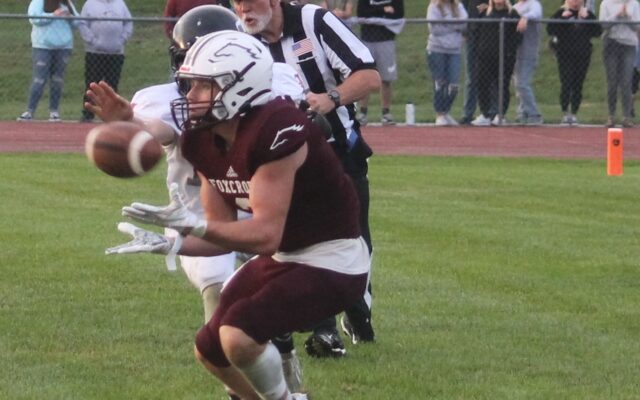
The growth of 8-player football could mean the end of Maine’s Class D ranks
By Ernie Clark, Bangor Daily News Staff
Maine’s small-school class for 11-player football teams is barely 50 percent of what it was just two years ago.
Class D, for schools with fewer than 400 students, once included North and South divisions that featured nearly 20 teams from two of the state’s well-known leagues, the LTC and Campbell Conference. Today, the small-school division is a grouping of just nine schools statewide, including Maine’s six smallest surviving 11-player programs.
As more schools flock to the growing ranks of eight-player football throughout the state, coaches fear that Class D 11-player football may disappear if the trend continues. And if the division were to be dissolved, some coaches worry it would inhibit teams’ abilities to grow their squads and fight to rejoin the 11-player ranks.
The state’s eight-player football community swelled from its original 10 schools in 2019 to 25 this fall, and the belief among some remaining Class D coaches is that more schools will make the same move if roster sizes continue their decade-long decline.
“I’m all about the preservation of tackle football first,” John Bapst coach Dan O’Connell said. “But ultimately I feel like there’s going to continue to be movement. I do believe some of these eight-man schools will come back to 11-man, and I also think there will be others in 11 now that head to eight.”
The number of high school football players in Maine decreased by 21 percent, from 4,029 to 3,213, during the 10 seasons between 2009 and 2018, according to the National Federation of State High School Associations annual participation survey.
That count hasn’t been conducted for the last two school years because of COVID-19, but those numbers in the Pine Tree State mirror the national trend. Since reaching an all-time high of 1,112,303 players in 2008, participation in 11-player football decreased every year through 2018 except the 2013-14 school year.
Seven of the nine teams in Class D North in 2019 are now playing eight-player football, leaving just Bucksport and Foxcroft Academy of Dover-Foxcroft to be joined this fall by Lisbon-St. Dominic, Oak Hill of Wales, Winthrop-Monmouth-Hall-Dale and Madison-Carrabec-Valley from Class D South.
Joining that contingent are three Class C schools — Freeport, John Bapst of Bangor and Poland — that have moved down to Class D under a new Maine Principals’ Association rule that allows teams to play at a level below the class dictated by enrollment and still be eligible for postseason play in order to preserve those programs.
Competition in the new-look Class D figures to be fierce this fall, as its current membership has combined to win four state championships and nine regional titles since the fourth class was reinstituted in 2013. Lisbon-St. Dominic defeated Bucksport in the 2019 state final.
“It’s really kind of crazy to think that the only teams we’re playing this year that we’ve played a lot in the past are John Bapst and Bucksport,” Foxcroft Academy coach Danny White said. “It feels like you’re almost jumping into state championship games right off the bat.”
Whether more small 11-player tackle football teams will shift to eight-player football is uncertain, as is how many more teams would have to make that move before the Maine Principals’ Association football committee would consider eliminating Class D and leave just three classes of 11-player football — as was the case before 2013.
Currently the smallest class in Maine’s high school football ranks is Class A, which is home to the state’s largest football-playing schools.
“The fact that there’s only one league in Class D speaks to where the numbers are going,” Bucksport coach Joel Sankey said. “It’s going to be interesting to see what happens.”
O’Connell is one of Maine’s bigger proponents of 11-player tackle football, yet he acknowledges the declining high school enrollments around the state and how it’s affected all sports, including football.
“As far as eight-man goes, I was a huge proponent of it and still am for the ability for a team with low numbers to continue to play tackle football,” he said. “I’m also a believer that if you can get back to 11-man you should try to do it.”
O’Connell relies on what he calls a “rule of three” as a primary step in determining whether a football program should compete in 11- or eight-player football, specifically whether a program has enough players for three full squads.
“If you have 33 kids or more I feel like you should be playing 11-man football, and if you have 24 or less then I think you’re an eight-man school,” he said. For programs with 25 to 32 kids, that’s where he said you have to evaluate your roster, program culture, coaching history and community support.
Sankey said Bucksport considered shifting to eight-player football before returning to Class D this fall with a 34-player roster.
“Right now the future of our program looks to be heading in the right direction when it comes to numbers, but we can’t afford to lose too many,” White said. “We’ve got to continue to work to keep kids involved in the program.”
Another reason support lingers for continuing Class D football is to provide programs that have moved to the eight-player version the option to return to 11-player competition if they are able to reinvigorate their participation numbers.
“I think the work that the Maine Principals’ Association and the scheduling committee and the schools involved did to preserve small-school 11-man football was very important work,” said O’Connell, whose John Bapst roster numbers in the low-30s this season. “I hope we can continue to maintain that.”